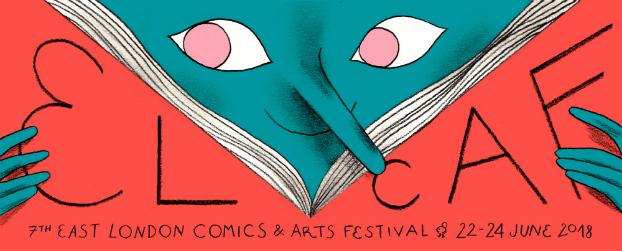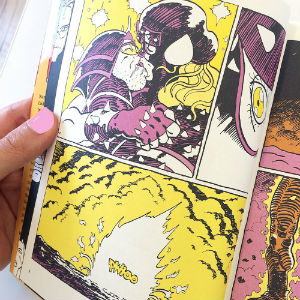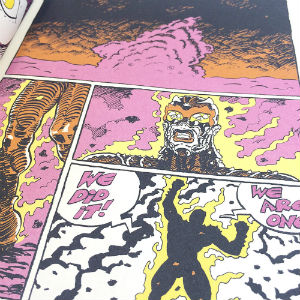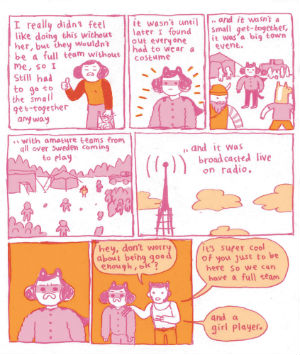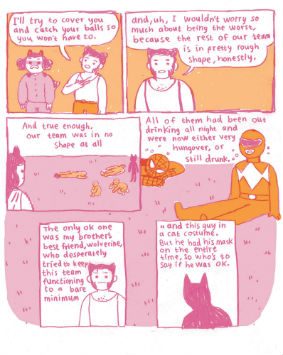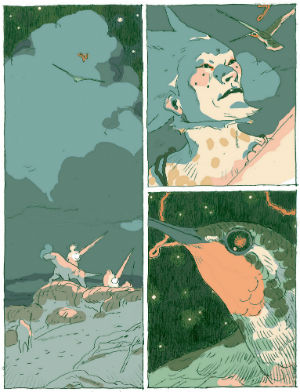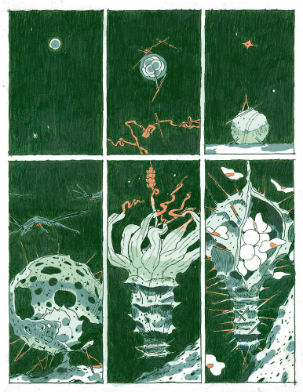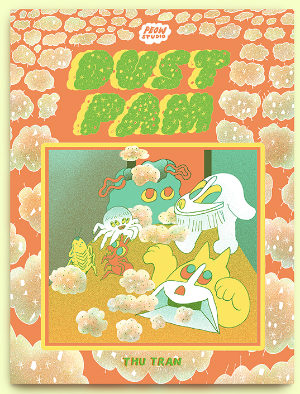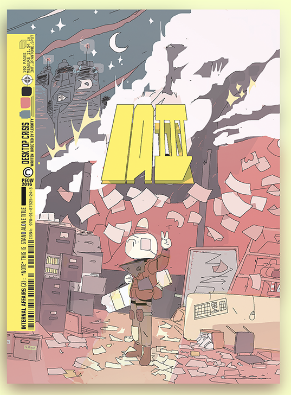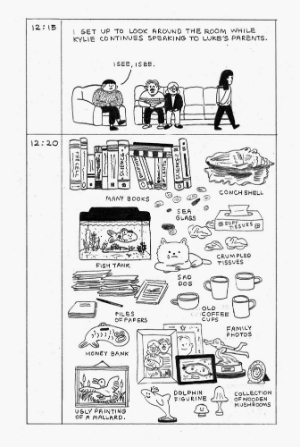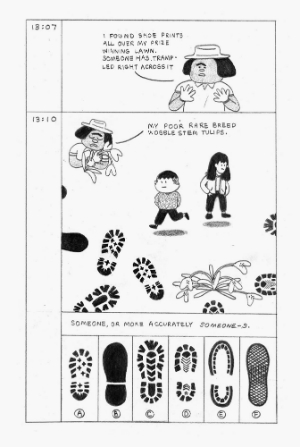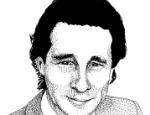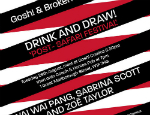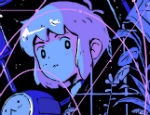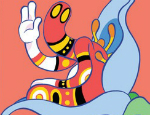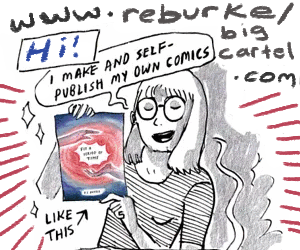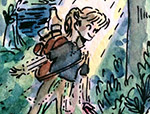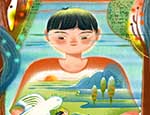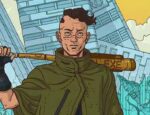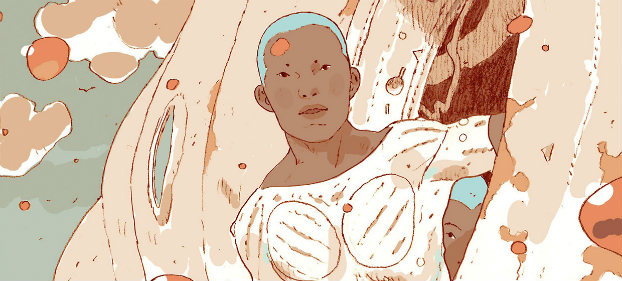
ELCAF FORTNIGHT!
The last time we spoke with Swedish micropublishing dynamos Peow Studio, they were coming off a hot streak of Ignatz nominations and a blockbuster Kickstarter campaign that funded their 2016 line. Two years later, they’ve given up the risograph printing side of the business to focussing on book publishing, split across multiple continents, and put out a bunch more interesting comics by excellent artists. In 2018 Zainab Akhtar (Shortbox, Comics & Cola) joined the team in the role of Editor-at-Large.
I first encountered Peow! with their 2015 collected edition of Valentin Secihe’s Wrecked Ship, and I’ve been a fan ever since. To start off I asked co-founders Olle Forsslöf and Patrick Crotty — both immensely talented illustrators and cartoonists in their own right, FYI — how they would describe the company’s MO, before getting down to the brass tacks of indie publishing, their goals for Peow!, and what they’ll be bringing to ELCAF this year.
BROKEN FRONTIER: To start off, could I ask you both to define what sort of books Peow publishes?
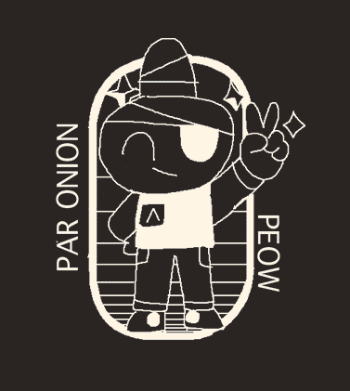 OLLE FORSSLÖF: What the books we publish have in common is that either me or Patrick is into something about the author or the artists. There’s no specific genre or style we’re really after. It’s just like either I like it, or Patrick likes it, or we both like it. So that’s the common theme, I guess.
OLLE FORSSLÖF: What the books we publish have in common is that either me or Patrick is into something about the author or the artists. There’s no specific genre or style we’re really after. It’s just like either I like it, or Patrick likes it, or we both like it. So that’s the common theme, I guess.
PATRICK CROTTY: I think what Olle is saying is pretty correct. I was trying to explain this to somebody a couple of days ago, and I was like “Well, the books we publish are the books that we want to read.” It’s really, I guess, kind of narcissistic of us. We’re just making stuff that we like and, hopefully, other people enjoy the same things. It’s a nice way of doing things, because it means that everybody who is reading our books really, honestly has the same taste as us, and we’re not just catering for anyone specific.
Also, it’s books that we want to read, but also books that we feel other people wouldn’t publish. Not necessarily that they wouldn’t publish them at all, but we feel like they aren’t going to be published any time soon. I know with bigger book publishers, once someone makes a book, it sometimes takes a year for it to come out. If we work with somebody we usually get to see the results pretty quick.
BF: What do you think the reason is for these books not being picked up by other publishers?
FORSSLÖF: I’m not sure! It’s not like we’re looking at the edges of the community and looking for who are the worst artists.
CROTTY: [Laughs]
BF: [Laughs] It’s not a charitable endeavour?
CROTTY: No, no!
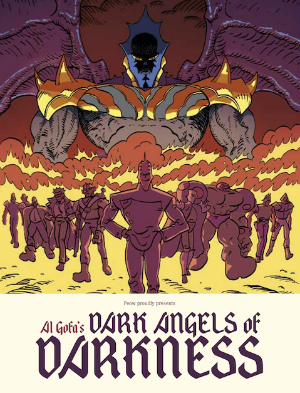 FORSSLÖF: Nothing like that! I think everyone we’ve worked with hasn’t made a comic before, or at least not a major comic book. They’re all debutants, more or less. A few of them are more into illustration, or animation. We’re taking on a lot of newbs, so to speak. Maybe bigger comic book publishers want to see the final comic laid in front of them, and say, “Yeah this is great, we will publish it,” while we are more like “Hey, do you wanna work together with us, we have maybe an idea or you could pitch us an idea and we can work on it together?” More often we’re building the book with the artist. We’re not taking any credit for the actual books, the story and stuff, but we often initiate the project with them.
FORSSLÖF: Nothing like that! I think everyone we’ve worked with hasn’t made a comic before, or at least not a major comic book. They’re all debutants, more or less. A few of them are more into illustration, or animation. We’re taking on a lot of newbs, so to speak. Maybe bigger comic book publishers want to see the final comic laid in front of them, and say, “Yeah this is great, we will publish it,” while we are more like “Hey, do you wanna work together with us, we have maybe an idea or you could pitch us an idea and we can work on it together?” More often we’re building the book with the artist. We’re not taking any credit for the actual books, the story and stuff, but we often initiate the project with them.
CROTTY: I think also the “risk” is these artists are often well-known on the internet for being really good at drawing, but maybe other publishers might be unsure since they don’t have a track record of making books before. And I know that a lot of the things that we do lean towards manga-inspired artwork, and I know, at least in the US, with indie comics, that isn’t as common. I don’t think that a lot of indie publishers want to work with stuff that looks like that. I don’t know if it doesn’t feel as “artful” to have that style, but a lot of people we work with, we’ve all grown up with this type of stuff and are inspired by it. At least from where we started out, in Sweden, there was maybe one or two styles that were really popular, and for us to be able to read anything else that we kind of enjoyed, the only option really was for us to create it ourselves.
BF: You say that a lot of the books Peow publishes are people’s first comic work. How do you find them? Is it meeting them at festivals, looking online, recommendations from other people?
FORSSLÖF: All three of those, actually. From the beginning, of course it started online, and then you realise people are friends with each other, and then you travel to festivals, maybe meet the artists and you meet their friends, and get introduced to other artists that way. Once the snowball starts rolling, you can pick them up almost anywhere.
Al Gofa’s Dark Angels of Darkness
BF: You’ve just been to Toronto, and then you’re coming to East London soon. Is there a lot of travelling involved in running Peow?
CROTTY: I think because we are in different countries — since I’m here in the US and Olle is in Sweden — we are able to make it to a lot of festivals because we are able to split it up. I don’t have to travel to every festival, and the same thing for Olle. So I guess as a whole, Peow does a good amount of travelling, but individually I think it’s a decent amount. I don’t think we would really push ourselves to travel every single weekend, just because.
FORSSLÖF: There is a lot of travelling actually, though. There’s maybe ten festivals a year, and okay some are in New York, one is in Stockholm. Then again you travel across America, and I go mostly to the UK, but sometimes within Europe.
CROTTY: Yeah, you were just in Oslo last weekend [Ed: For Oslo Comics Expo].
BF: Being able to travel, being split in that way allows you to cover a lot of ground, but have you come across any challenges in running the publishing side of things with you guys in different places?
CROTTY: Yeah. We split up like this a couple of years ago, and as time goes on I always feel like it is harder to communicate and get things done when you are so far away from each other. Especially when there’s really small thing, like I would need to ask one simple question, and it’s like, well, I have to wait until tomorrow to get the answer, because Olle is probably sleeping right now. Those kind of things are always hard to just figure out, and you kind of take it for granted when you are working together in the same office. It’s more just the really quick interactions between each other that go missing.
Anna Syvertsson’s Rule Break
FORSSLÖF: It’s the small communication that is hard. And I also miss working together in the same room, or in the same office space, but this works out as well. I mean, this is actually better for Peow as a publisher, to have Patrick in the US.
CROTTY: I miss being able to shout at people for no reason! And just like, even small stuff like, hey we did something like, okay! Now we can celebrate! Let’s have a beer together! Stuff like that you don’t get to do any more. It really is stuff like that that I miss.
FORSSLÖF: Yeah, and we were really good at celebrating stuff as well!
CROTTY: Yeah, yeah! And you could like help each other out with stuff like, oh we have make this scary phone call for…it could be whatever, but you could be like, “You can do it, it’s going to be okay!” All that kind of stuff is kind of gone, and it makes it…now I’m getting, I haven’t really thought about it, it’s like you’re this therapist who’s brought up these weird emotions that I didn’t know I had…I feel really bad now!
FORSSLÖF: Oh, come on, come on.
Stages of Rot by Linnea Sterte (also top banner image)
BF: Let’s move on from emotions then! What would you say your goals are with Peow, and have they changed from what your goals were when you initially started?
FORSSLÖF: I’d say. Since we actually decided to be a publisher, which was a couple of years in, we always had our one year goals. Like, we’re gonna make our first book that has 200 copies, we’re going to make our first book which has 500 copies, and then it’s gonna be like, I don’t even remember, more than 100 pages!
CROTTY: And like a hardcover book! Some goals we have not met yet.
FORSSLÖF: But the ones we had set out to do within the year, we actually did each year, and eventually that turned into: we’re going to make our first offset printed book! And now that’s all we do! For the both of us, now, I want this to work so that this could be our only work, you know? For a living. That’s the main goal. I love working with comics and books and doing the publishing thing, editing, and everything that comes with it. But I just want to be able to live off it, that’s all.
CROTTY: I don’t know if Olle said, but when we first started we were doing risograph printing, because we were the only ones in Sweden to have that. So we were doing the printing and the bookmaking, and there was a turning point where we were like, let’s only make books. But I think also the books that we want to make have changed a lot to. In the start we just made whatever, like “oh this person is good at drawing, let’s just make it.” Since then we’ve thought a lot more about the books that we make, what does it feel like when we finish reading the book, just a lot about making sure that our books are accessible as possible, to anybody who’s reading them. We do a lot more with the editing than we used to. And I think we also think about, say we can also only publish 10-15 books a year, it’s not very many, so that means every author kind of counts. So we have to make sure that everybody that we work with is somebody we really want to work with.
I think also, even more now we’re thinking more about representation with which type of artists that we work with, because some publishers, you’ll see their releases for a whole year, and they only released titles by white men. A lot of times when you’re starting out you don’t think about this, it’s like “Hey this is fun we’ll just do what we want!” And they are good artists, the people that we work with, but it’s like, okay, we can only pick a few people to work with each year. So thinking about that, it is even harder because the three of us who started Peow are just three guys. When we published the three of ourselves, it was like, “damn, now we have to find like, three other non-us people.”
TB: Like this line-up here? [Ed: Before we started it was noted that all three of us were young white men, wearing white t-shirts and glasses]
CROTTY: Small things like that I think are important, because there are so many things being published nowadays, so we try and do good. I think editing is a big thing that we’ve thought a lot more about, and I think it takes longer and longer with each book. I feel like the direction of how comics can go is like, and I say this a lot, a lot of times comic publishers will make comics for people who are already comic book readers, and you try to make comics move forward as an art, you say “okay, this is going to be innovative for people who already know the language of comics!” And that’s really, really cool, but for us it’s kind of different. I feel like more often we would want the comics to be more open, so that somebody who doesn’t read comics at all can read this and think, “this is really interesting and I want to get into comics.” Books that you would be okay giving to your parents and be like “Hey, this is this book, hope you enjoy it,” and not have them be like “I’m confused, what’s going on here?”
That’s the two different things, and I think that can come across as kind of strange for other, ingrained comic readers who are like, this is not really advanced in what they’re doing, but I feel like for us the message, whatever the message the artist is trying to say, we want to make that as clear as possible in our books, rather than hidden, or something that you would have to analyse to figure out.
BF: What is the editing process like? I’m assuming it’s different from book to book, but are you bouncing ideas off artists, are you looking at scripts, are things being revised as they’re being drawn?
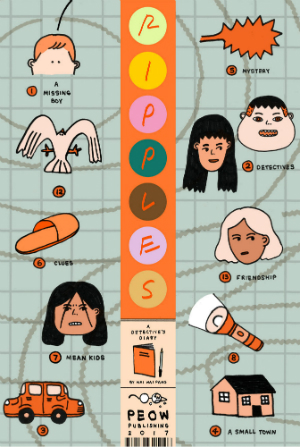 FORSSLÖF: It’s very different from artist to artist, I would say. And it’s something that I am constantly trying to improve on, because I have no editing education to go on, so you just go by a feeling. It’s everything from reading thumbnails and saying, like, “Hey, it looks great!” Or, maybe you spot something and say, “What about this?” You always kind of make suggestions. And sometimes it’s like, I don’t want to change anything but you check all the spelling, make sure the language is good. When I worked with Al Gofa, who is French-Canadian, it’s a lot more in the language, to translate it into actual good English. And I’m not the best at English either!
FORSSLÖF: It’s very different from artist to artist, I would say. And it’s something that I am constantly trying to improve on, because I have no editing education to go on, so you just go by a feeling. It’s everything from reading thumbnails and saying, like, “Hey, it looks great!” Or, maybe you spot something and say, “What about this?” You always kind of make suggestions. And sometimes it’s like, I don’t want to change anything but you check all the spelling, make sure the language is good. When I worked with Al Gofa, who is French-Canadian, it’s a lot more in the language, to translate it into actual good English. And I’m not the best at English either!
CROTTY: For me at least, a couple of times there’s been artists I have found and I say, I want you to make this type of book. I haven’t given them a story, but for Wai Wai [Pang], I told her, I would love to see this type of style, but in like a mystery or police-type story. Because around that time I had read Black Blizzard, the Yoshihiro Tatsumi book, and I really like how a lot of those old books can have very simple mysteries, that’s kind of like the vibe that I wanted.
And she came up with something [Ed: Ripples, as reviewed by our fearless leader Andy Oliver, pictured above right and below], and it worked out really, really nice. Actually there is one person I’m working with now, also, again I love the cop-and-robber-type-stories! But this person is also doing, well, I gave them a few different ideas of what to do…No no, they came with a few ideas, here’s three or four different ideas — and one of them, I had told them, tell me your ideas, but give me at least one police story. And I really liked the police story, so it’s another police story.
BF: [Laughs]
CROTTY: I feel like without motivation, people don’t want to do a police story any more! But it was always in the old manga stuff, there is, you know, that is like a simple thing, and everybody gets it, and I think that was the thing. I want to have this story be a thing most people can relate to. There’s a reason why they’re really popular in other things, in TV and other books, but I think comic people are so intent on being weird and extreme that they are like, “Oh, I can’t have something as simple as a mystery!” So yeah, the editing, what Olle said a lot of it is just making sure books look nice, but then again we’ll have to have the story stuff. One of the main things that got us into this is that we had a couple of books where we just felt the ending was, you get to the end and it was like, “Is that it? Does it just end like this?” And that is something we wanted to avoid, because you know that feeling where you buy zines at festivals, or books, and the worst thing is when you spend your money and you read a book and it ends and it’s like, this is not an ending.
 BF: To bring it all back to ELCAF here at the end, what books are you going to be bringing with you, Olle?
BF: To bring it all back to ELCAF here at the end, what books are you going to be bringing with you, Olle?
FORSSLÖF: We were supposed to have two new books this spring, that were supposed to be debuting at TCAF. And they both did actually, but one of them turned out to be misprinted, so the pages in the middle were in the wrong order. So we’re not selling that any more, and it’s being reprinted! So we have like one new book, which is Angels of Darkness, by Al Gofa. For ELCAF, since last year we have five or six titles that we didn’t have last year. So quite a few new books!
CROTTY: That’s our last festival for the summer, too. We have a few books coming out, actually, this summer, which are not going to be at any festival. The one I was talking about, the cop-and-robber book, it’s like a detective, and a robber, and a lot of food, that’s called Mani, by Diigii Daguna, that is coming out in like a month. And then we’re reprinting Junky, the big artbook we did with Guillaume Singelin. So those will be stocked up for the Fall festivals.
Peow will be exhibiting at ELCAF. For more on Peow Studio visit their site and store here and follow them on Twitter here.
Catch up on all our ELCAF Fortnight articles to date here. ELCAF runs from June 22nd-24th. Full details on the ELCAF site here and you can also follow the festival on Twitter here.
